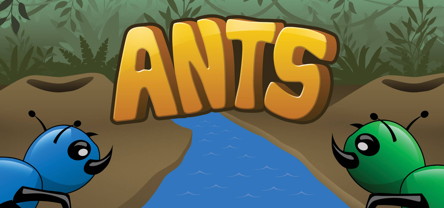|
Today would be our first night on a small tropical island. But first, we
woke up to the sounds of the birds once more, and got ready for
our 6:20 ride to the boat dock and our third cruise of the Daintree
River.
We packed our bags and left them in our villa to be taken later.
Then we met our driver and took the short drive to the boat dock.
The sun was already rising, and it shone beautifully through the
clouds, creating crepuscular rays, otherwise known as God beams.
Our boat and guide weren't there yet, so we waited with our driver
for about 10 minutes. Finally, a big covered boat -- seats about
24 -- came by. Jean and I were at first disappointed not to see
Dan. Instead, our guide was Dan's partner Peter, whose one shared
trait with Dan seemed to be that he was barefoot as well. We'd
get over our initial disappointment, however, as Peter turned
out to be an excellent guide.
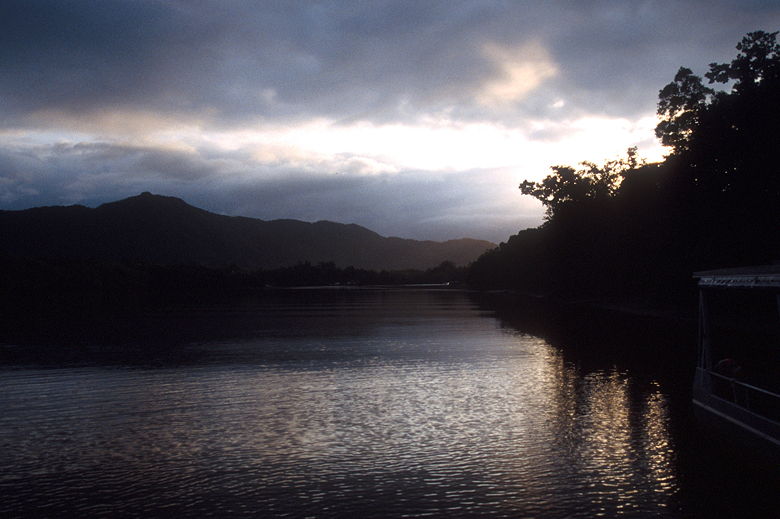
Sunrise on the Daintree River
Our driver left us and Peter took the two of us out for a personal
tour. We were the only other people in the boat, and we appeared
to be the only boat out on the water. Obviously, this made for
a very peaceful time, especially in the early morning. the water
was still, the sky was mostly clear, except for some low clouds
on the horizon.
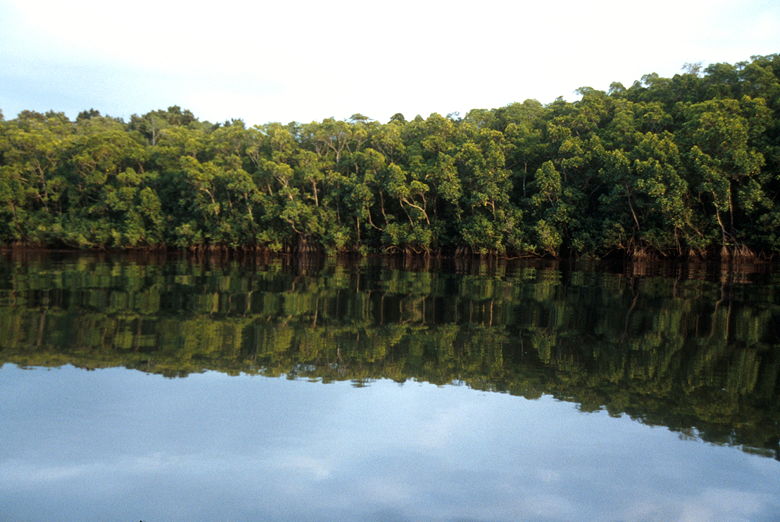
Mangroves reflecting the early morning light on the Daintree
There were no fruit bats circling in the sky. There wasn't much
wildlife around at all. But we did see a few birds, and Peter
taught us more about mangrove trees than we thought possible.
But first, we spotted the gray-billed egret. Peter told us that
if we ever spotted a bird watcher (easily spotted with the hat
and big binoculars), we should taunt them by saying, "Have you
seen the gray-billed egret? (dramatic pause) Because I have!"
Apparently they're quite a rare sighting. The bird was walking
along a beach in a narrow creek, slowly walking away from us.
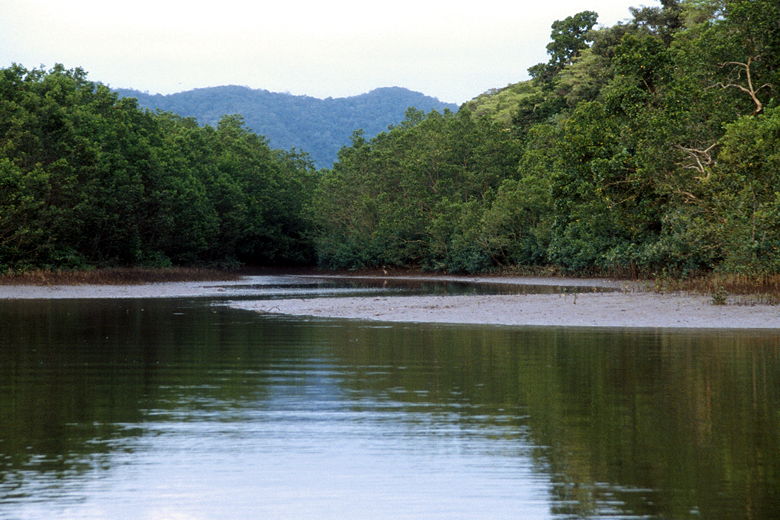
The elusive gray-billed egret walking away from us
Peter took us into a 9-meter wide side creek. This is important,
since the boat is 9 meters long and he needed all the space he
could get to turn it around later. In the meantime, he told us
about mangroves. For example, he showed us a mangrove seed which
grows long, about half a meter long, and narrow, with a point
at one end. It can do one of two things -- drop straight into
the ground near the tree and start growing there, or drop into
the water and float away and grow somewhere else. The very interesting
thing about the seed is that it orients itself differently depending
on the salt content. If there's too much salt -- too much salt
for it to grow properly -- the extra buoyancy causes the seed
to pop up and float sideways. This way, it just keeps floating.
If the water is sufficiently unsalty, the reduced buoyancy causes
the seed to float point down, and so it can burrow itself into
the ground and start growing in an appropriate place. Fascinating.
It was quite obvious that Peter is passionate about his mangroves.
As he put it, rain forests are boring -- any old plant can grow
there. But down by the river, where you get fresh water, salt
water, and it gets flooded twice a day, only mangroves can thrive.
There are 29 species of mangrove that grow on the Daintree River.
All of them are trees except for one species of fern.
Back out on the main river, we noticed the flies starting to buzz
around us again. We borrowed Peter's bug spray and used it on
ourselves. That seemed to keep them away.
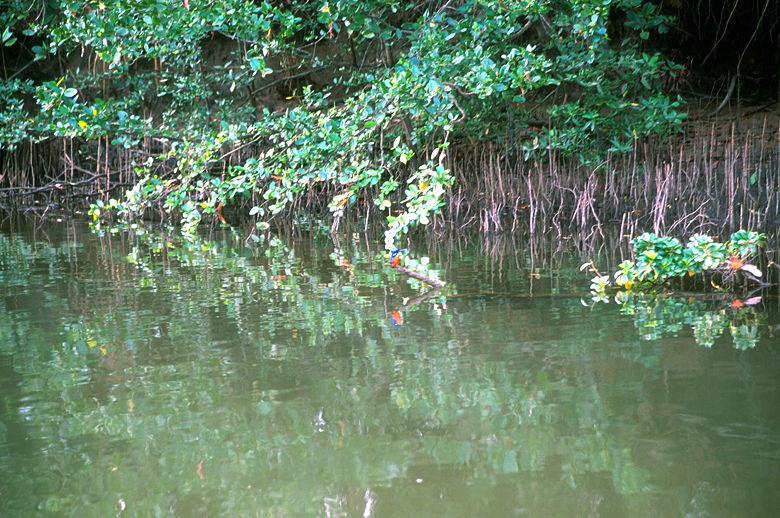
Cute little kingfisher (orange and blue bird in center)
Along the edge of the river, we spied a couple Kingfishers chasing
each other. We got a special treat when we saw one jump into the
water with ninja-like quickness and pull something out. Peter
said it looked like he'd caught a shrimp, which are common in
these waters. That shrimp never had a chance; the Kingfisher was
in and out of the water at the snap of a finger.
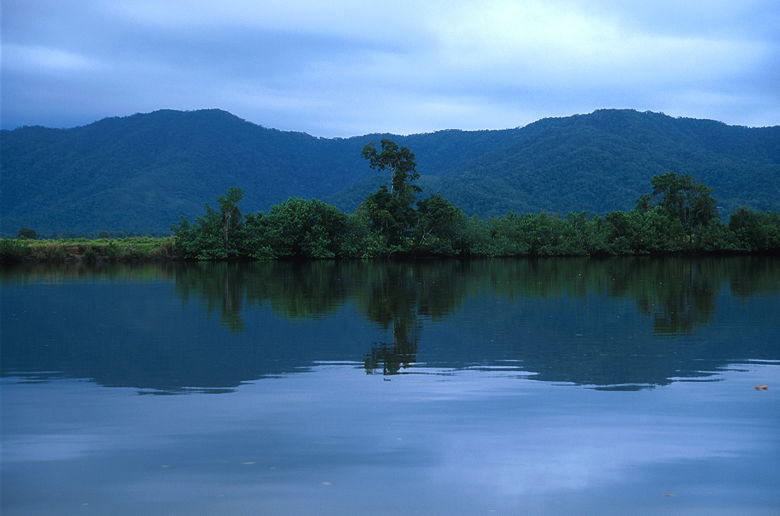
Mountains reflecting in the Daintree
Peter claimed that once in a while he takes a net and catches
a bucket full of shrimp to eat. They put some restrictions on
net size and don't allow commercial fishing, but other than that,
the locals are free to enjoy the benefits of the river. There
aren't that many locals. There are just 150 residents of Daintree
Village, up the road from the lodge, and about 1500 in nearby
Mossman. That's about it.
They grow lychees and mangoes and other tropical fruits in the
area, but they don't sell them much locally. Locals simply ask
a neighbor for fruit growing in their backyard. Most of the crops
are exported to Japan and other nearby Asian countries, where
people will pay a premium for the fruit. In reality, Japan isn't
all that much further than Sydney. And they'll pay as much as
$35 for a mango there, depending on the season.
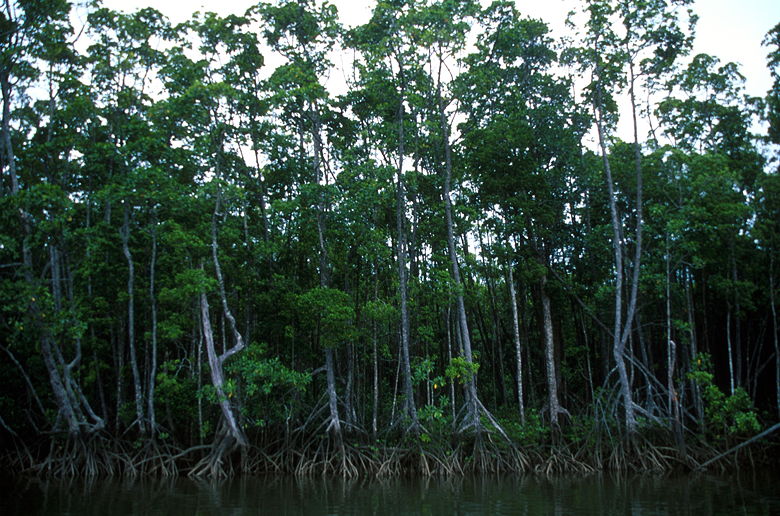
Mangrove forest
Peter was telling us of a local organic banana farm and then gave
us a colorful story about a friend of his. Apparently his friend
loves tropical fruits but isn't allowed to bring them to his country
because of customs regulations. So what he does is eat a lot of
fruit just before he flies home -- including the seeds. And then
he goes home and makes a deposit in his garden. Unfortunately
I don't think that would work with mangoes.
He did tell us something about mango trees which was at least
entertaining and at most possibly useful in the future. If a mango
tree isn't bearing many fruit, Peter says to drive a tractor into
it. The shock will make the tree think it's in danger and will
start bearing more fruit as a survival mechanism. If a tractor
isn't handy, a few nails driven into the trunk might do the trick.
Finding a leaf with the white poison that's supposed to stupefy
fish, Peter spread it all over his hand and nothing happened.
Apparently it affects some people but not all. Every time he's
tried it he's never had an adverse reaction. Jean and I, not being
so brave, decided to pass on the invitation to spread it on ourselves.
The bug spray was bad enough.
After two great peaceful hours on the river, Peter brought us
back to the dock, where our driver was waiting. We made a brief
stop at a gas station along the way. The cost is about $1 AUD
per liter for automobile gas. The Aussies were complaining about
gas prices, but that comes out to about the same price as the
Bay Area. Of course, people complain about it in the Bay Area,
too.
We drove back to Cairns International Airport. It's not a huge
airport, but they do fly to Japan and Hong Kong. We were taking
a small plane on Transtate Airlines. Our driver had never heard
of that and thought we might be in the small plane area, but he
couldn't find it. Eventually we asked and discovered that it was
at the main Ansett terminal.
The woman at the check-in counter warned us that our bags would
be too heavy for the small plane. So we went to the nearby locker
and started doing some rearranging of our bags. We put all the
stuff we didn't need (most of our camping and hiking gear) into
a large locker, which cost $10 AUD per day. We then checked in
and were on our way.
I cringed again going through the x-ray machine, but there wasn't
much I could do. At least I left some of the film in the locker.
Inside at the gates, it was a mad house. Almost every seat was
taken, though it would soon die down as people boarded their flights.
We had a few minutes to kill so I stopped in at another Internet
cafe next to Burger King, where it was $3.95 AUD for 20 minutes
of usage. I sent a few notes to friends and then we boarded our
plane.

Flying over the mainland
I have an intellectual fear of flying in small planes. I mean,
I know small planes are more dangerous than big jets. But I call
it an intellectual fear because I didn't actually feel any fear. If I was ever going to feel any fear of flying, this
was going to be it, because this was the smallest plane I've ever
been on. It was a Twin Otter, seats about 18 passengers, two crew.
It was packed, and no in-flight movie or beverage service, either.
:) The two crew were both in the cockpit, and no one could hear
anything over the sound of the engines.
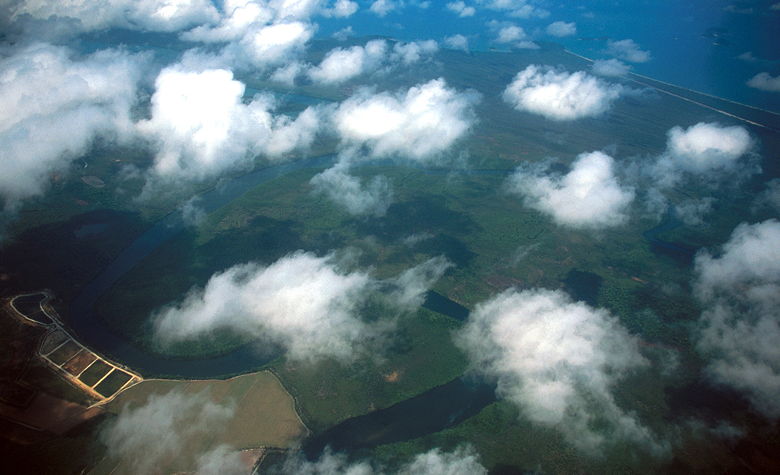
Clouds over the mainland
Thankfully, it's only a 45 minute flight to Dunk Island from Cairns.
Along the way I was able to take my first aerial photographs.
Considering I took them through a double-plated window, they didn't
turn out too bad. We flew over the ocean, over snaking rivers,
over the coral reef, over clouds and cloud shadows. Eventually
we could see Dunk Island itself and the runway on one side of
the island.
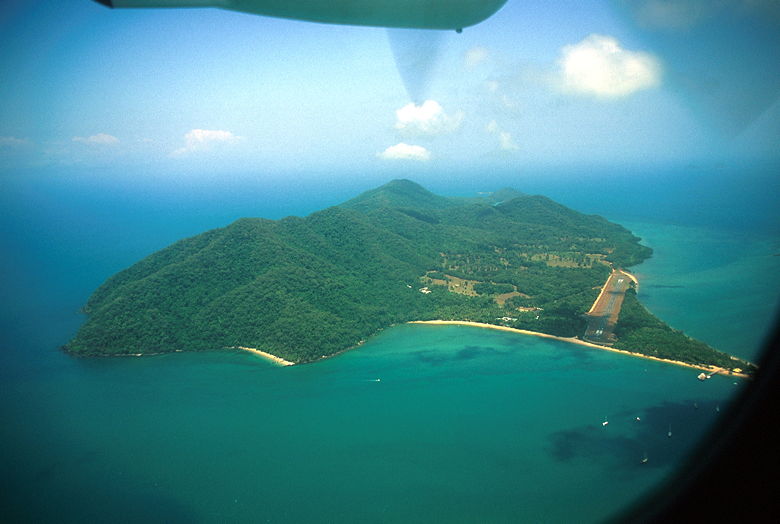
Dunk Island
We landed and taxied back to the welcome station. Ever seen Fantasy
Island? It was just like that. We were greeted by a guy (his name
might have been Mr. Roarke, I didn't ask) with a tray full of
punch in plastic wine glasses. The sun was beating down on us, and we were happy
to gather underneath the shade of the reception building. We all
checked in as another group of folks boarded the plane for their
departing flight.
They gave us a brief tour of the facilities before leading us
to our room. After Port Douglas and especially Daintree, this
was quite a change. In comparison, Dunk Island is almost a metropolis.
It's definitely a resort island, with a cascading swimming pool,
another pool for snorkel and scuba lessons, a golf course, gym,
three restaurants, lounge, spa, gift shop, and lots of rooms.
The resort is pretty much the only thing on the island, but it's
very concentrated, occupying a small portion of the island by
the air strip.
After a short rest we had some snacks at EJ's before venturing
over to the activities center to join some folks for boomerang
throwing in the afternoon. We were given minimal instructions
before taking turns, one at a time, throwing a boomerang on the
golf course. Jean was much better at it than I was; I was a bit
tentative at first, not wanting to show off too much strength.
:) Basically, the idea is to throw 45 degrees into the wind, with
the boomerang tilted at a 1 o'clock angle from vertical.
We tried to see who would be the first to catch their own boomerang.
I almost caught someone else's, but it slipped off my hand. A
few times we scattered as a wayward boomerang went off course
and came screaming down at us at head level. You could hear the
whoosh whoosh of the boomerang as it sliced through the air. Two
or three people did actually catch their boomerangs, although
they had to run a bit to catch them.
The resort is beautifully decorated with flowers and even has
a fruit and herb garden we would visit later at night. We ate
at EJ's, the restaurant on the deck, that night. We again noticed
the strong Asian influence on the menu. The food didn't quite
compare to the Eco-Lodge, but it was pretty good and the portions
were large.
After dinner we took a walk through the garden. Jean used my headlamp
to illuminate the different plants and identify them. We made
a very special discovery, finding a cocoon-like bird's nest hanging
from one of the posts meant for hanging plants. What made it special
was that there was a small bird inside it, all wrapped up inside
except for his beak showing. He was so cute just sitting there,
sleeping. Jean wanted me to take a picture, but I was worried
the flash might disturb him. I would change my mind later that
night, but by then we were too tired to go back outside.
We walked through the garden and found herbs, chili peppers, pineapple,
and other tropical plants. On our way back, we also noticed frogs
everywhere. They jumped out of our way as we walked by, but it
was somewhat freaky having so many frogs in one place. Somehow
we made it back to our room without stepping on one.
| 








